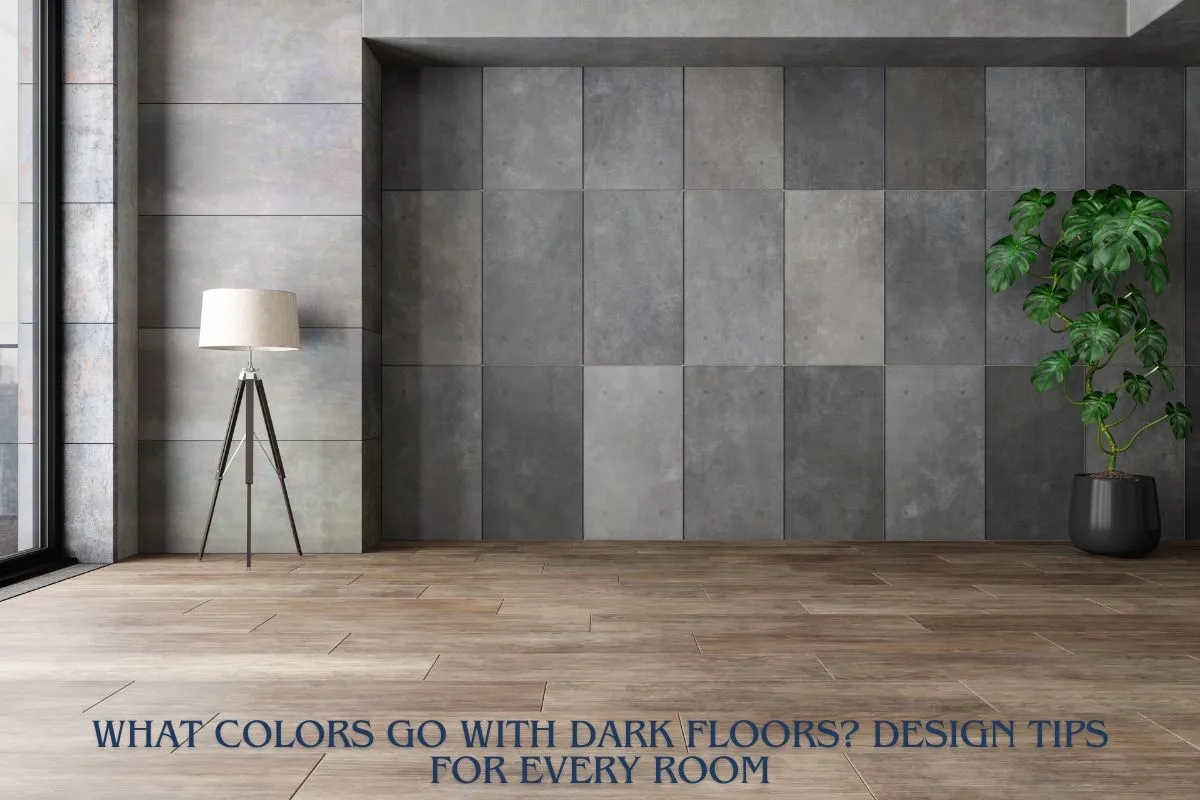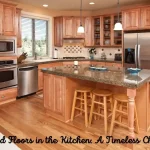Dark floors are a timeless choice for any home. They add elegance, drama, and a touch of sophistication to any space. However, choosing the right colors to pair with dark floors can be tricky. You want to create a balanced, harmonious look that feels inviting and stylish. In this article, we’ll explore the best colors to pair with dark floors, tips from top interior designers, and how to create a cozy and chic space.
Why Dark Floors Are So Popular
Dark floors have been a favorite among homeowners and designers for years. They’re versatile, easy to maintain, and make a room warm and inviting. Whether you have dark hardwood, tile, or laminate, these floors provide a stunning base for your decor.
I remember when my husband and I were renovating our living room. We chose dark walnut floors because they looked rich and elegant. But when it came to picking wall colors, we were stuck. We didn’t want the room to feel too dark or heavy. After some trial and error (and many paint samples), we finally found the perfect balance. The result was a space that felt both cozy and bright—a place we love spending time in.
| Aspect | Details |
|---|---|
| Best Wall Colors | Light neutrals (white, beige, cream), warm tones (soft gray, taupe) |
| Accent Colors | Jewel tones (emerald green, sapphire blue), metallic finishes (gold, brass) |
| Modern Schemes | Monochromatic (black, gray, white) |
| Soft & Calming | Pastels (blush pink, light blue, mint green) |
| Why Light Neutrals? | Create contrast, brighten the space, and balance dark floors |
| Why Warm Tones? | Add warmth and coziness to the room |
| Why Jewel Tones? | Add luxury and drama, perfect for accent walls or decor |
| Why Metallics? | Reflect light, add brightness and sophistication |
| Why Monochromatic? | Sleek, modern, and cohesive look |
| Why Pastels? | Soft, calming, and perfect for creating a light, airy feel |
| Decor Tips | Add texture (rugs, throws), use mirrors, layer lighting, incorporate plants |
| Best For | Living rooms, bedrooms, kitchens, home offices |
| Common Myths | Dark floors don’t make rooms feel smaller; they’re versatile and timeless |
Additional Notes for Viewers:
- Small Spaces: Pair dark floors with light walls and furniture to avoid a cramped feel.
- Maintenance: Dark floors hide scratches and stains well but may show dust more easily.
- Versatility: Dark floors work with any design style, from modern to traditional.
- Lighting: Use layered lighting (overhead, lamps) to brighten the space and create warmth.
What Makes Dark Floors Special?
1. They Create Drama
Dark floors add depth and contrast to a room, making it more dynamic and engaging.
2. They’re Timeless
Unlike some trends that come and go, dark floors have a classic appeal that never goes out of style.
3. They’re Versatile
Dark floors work with various design styles, from modern to traditional.
Best Colors to Pair With Dark Floors
Here are some of the best color combinations to try with dark floors, along with tips from top designers:
1. Light Neutrals (White, Beige, Cream)
Light neutral walls contrast with dark floors, making the space bright and open. Joanna Gaines, interior designer and TV personality at Magnolia, says, “Dark floors create a dramatic and elegant base, and pairing them with light, neutral walls can create a stunning contrast.”
- Why It Works: Light neutrals balance the darkness of the floors, creating a fresh and airy feel.
- Best For: Living rooms, bedrooms, and kitchens.
2. Warm Tones (Beige, Soft Gray, Taupe)
Warm tones add warmth and coziness to a room with dark floors. Nate Berkus, interior designer and TV host, recommends, “When working with dark floors, consider using warm tones like beige, cream, or soft gray to balance the space and add warmth.”
- Why It Works: Warm tones create a harmonious and inviting atmosphere.
- Best For: Family rooms, dining rooms, and home offices.
3. Jewel Tones (Emerald Green, Sapphire Blue, Deep Purple)
Pair dark floors with jewel-toned accents for a luxurious and bold look. Interior designer and stylist Emily Henderson suggests, “Dark floors can make a room feel cozy and intimate. Pair them with rich, jewel-toned accents like emerald green or sapphire blue for a luxurious look.”
- Why It Works: Jewel tones add depth and richness, creating a dramatic and elegant vibe.
- Best For: Accent walls, furniture, and decor in living rooms or bedrooms.
4. Metallic Finishes (Gold, Brass, Chrome)
Metallic finishes add brightness and sophistication to a room with dark floors. Kelly Wearstler, interior designer and author, advises, “To avoid a space feeling too heavy, incorporate metallic finishes like gold or brass to add brightness and sophistication.”
- Why It Works: Metallic accents reflect light, making the space feel brighter and more dynamic.
- Best For: Lighting fixtures, hardware, and decor accents.
5. Monochromatic Schemes (Black, Gray, White)
For a modern and sleek look, try a monochromatic color scheme. Bobby Berk, interior designer and TV personality at Queer Eye, says, “For a modern aesthetic, combine dark floors with monochromatic color schemes, using shades of black, gray, and white for a sleek, cohesive design.”
- Why It Works: Monochromatic schemes create a clean, streamlined look that feels modern and sophisticated.
- Best For: Contemporary living rooms, kitchens, and home offices.
6. Soft Pastels (Blush Pink, Light Blue, Mint Green)
Soft pastels add a touch of sweetness and lightness to a room with dark floors.
- Why It Works: Pastels create a soft, calming contrast with dark floors.
- Best For: Bedrooms, nurseries, and bathrooms.
Tips for Decorating With Dark Floors
1. Add Texture
Incorporate different textures, like plush rugs, velvet furniture, and woven baskets, to add depth and interest to the space.
2. Use Mirrors
Mirrors reflect light and make the room feel brighter and more spacious.
3. Layer Lighting
Combine overhead lighting, table lamps, and floor lamps to create a warm and inviting ambiance.
4. Incorporate Plants
Plants add life and color to a room, balancing the darkness of the floors.
5. Choose the Right Rug
A light-colored rug can help break up the darkness of the floors and anchor the space.
Personal Anecdote: My Living Room Makeover
When we first installed dark walnut floors in our living room, I was worried the space would feel too dark. We painted the walls a soft gray, which helped brighten the room. But it wasn’t until we added a sizeable cream-colored rug and some metallic accents that the space came together. The carpet added warmth, while the gold finishes reflected light and added a touch of glamour. Now, our living room feels cozy, elegant, and perfectly balanced.
Unique Insights About Dark Floors
1. They Make Small Spaces Feel Cozy
Dark floors make a small room feel cozy and intimate, especially with light walls and furniture.
2. They Hide Dirt and Scratches
Dark floors are great for hiding dirt and minor scratches, making them a practical choice for busy households.
3. They Work With Any Design Style
Whether your style is modern, traditional, or eclectic, dark floors can adapt to your vision.
Common Myths About Dark Floors
1. Myth: Dark Floors Make a Room Feel Smaller
Fact: When paired with light walls and furniture, dark floors make a room feel cozy and inviting without shrinking the space.
2. Myth: Dark Floors Are Hard to Maintain
Fact: While they may show dust more efficiently, dark floors are excellent at hiding scratches and stains.
3. Myth: Dark Floors Only Work in Modern Homes
Fact: Dark floors are versatile and can work in any design style, from traditional to contemporary.
Conclusion
Dark floors are a beautiful and timeless choice for any home. By pairing them with the right colors and decor, you can create an elegant and inviting space. Whether you prefer light neutrals, warm tones, or bold jewel tones, there’s a color combination that will work for your space.
So, if you’re considering installing dark floors or updating your current decor, don’t be afraid to experiment. With the right balance of colors and textures, you can create a stunning interior that you’ll love for years.










